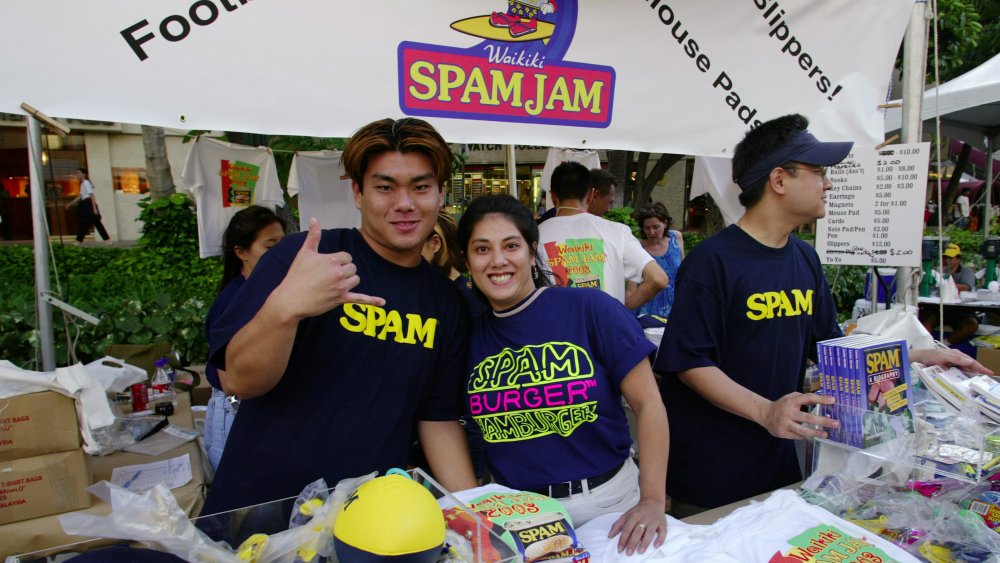The Real Reason Spam Is So Popular In Hawaii
For many of us, Spam may seem like a kind of joke food. After all, if it was a food product anyone took seriously, such as filet mignon or even fried chicken, its name wouldn't have been co-opted to describe email that tells us we've just won $6 billion or offers pills to enlarge body parts many of us don't even possess. If you've ever been to Hawaii, though, or eaten at a Hawaiian restaurant or food truck, you couldn't have failed to notice that Spam plays a starring role in that state's cuisine. What's up with that? Doesn't Hawaii have all kinds of delicious foods of its own such as pineapples and kalua pork? Then again, they do eat poi, which, by comparison, makes Spam taste just like that aforementioned filet mignon. (Poi, which is mashed taro root, might be seen as Hawaii's answer to Australia's Vegemite — something that is only favored in its place of origin and universally loathed elsewhere.)
Well, if you've ever tasted Spam musubi (which is basically sushi made with Spam instead of fish), spam fried rice, or the hot breakfast of fried Spam, eggs, and rice — a dish so well-liked throughout the islands that The Hawaii Plan says the state's McDonald's and Burger Kings feature this on their menus — you won't be finding Spam so laughable. In fact, it can actually be quite delicious. But how did Hawaiians discover this fact decades before the rest of us started catching on?
The history of Spam in Hawaii
Live Your Aloha relates that Spam arrived in the islands during WWII, along with a few zillion soldiers and sailors. While Spam was originally used to supplement those tasty wartime C-Rations, this extremely shelf-stable staple soon found its way off the military bases and into islanders' pantries. Food historian Rachel Laudan (via Eater) theorizes that the reason Spam caught on and became so widely accepted by the locals is out of sheer necessity. In Hawaii, Japanese immigrants were so numerous that it was impossible to place them in internment camps as was done in certain areas of the U.S. mainland, but since they were still seen as a security threat they were no longer permitted to fish. That put a huge dent in the commercial fishing industry, and also severely limited what had been the main source of protein in the Hawaiian diet at that time. Enter Spam to great acclaim, since even weird, pink, rectangular meat is better than no meat at all.
Why Hawaiians still love Spam
As to why Spam is still so popular in Hawaii, a little ingenuity and a knack for preparing it with flair turned this maligned mystery meat into the island's favorite treat. 7 million cans are sold there every year, according to the Spam website, which is about 5 cans for every man, woman, and child — this sounds a little on the low side, but then, perhaps some of the keiki (kiddies) aren't yet eating their share.
Plus, as Only In Your State points out, Hawaii is one of the earth's most isolated major population centers, and, as a result, they still need to import much of their food, since people cannot live on pineapple alone. Fresh meat can be very expensive, yet the beloved "Hawaiian steak" in the blue can remains affordable. What's more, Spam returns Hawaii's love, manufacturing special varieties just for the Hawaiian market such as the tasty-sounding teriyaki and Portuguese sausage flavors.
Still think Spam may not be your jam? Don't eat it out of the can! Instead, do as the Hawaiians do, and use it to whip up a yummy snack or entree, maybe even Spam fries. Once you eat it as it's meant to be eaten (cooked), you could find yourself stocking up on this stuff and making your own onolicious grindz. In fact, you may even be tempted to make a pilgrimage to the annual Waikiki Spam Jam, a celebration of all things Spam, Spam, Spam, Spam!


